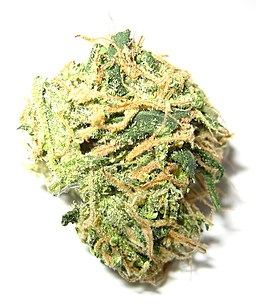Tenfold Increase in ‘Adult Weed’ Fuels Marijuana Industry Boom by 2020
Although it remains prohibited at the federal level, 23 states have in recent years approved the use of marijuana for medical purposes, while 4 states (Washington, Oregon, Colorado and Alaska, plus DC) also allow recreational use by adults.

This year is a tipping point: a further 7 states are voting on adult use and another 4 on medical use in 2016. Adult use may well become legal in crucial states such as California, Nevada and Massachusetts. By the end of 2016, it’s likely that a clear majority of states will have moved from prohibition to legalization of some sort – all in less than half a decade.
As this GIF shows, wider and broader legalization will have a huge impact on the official marijuana market. Between now and 2020, sales are set to triple, from an estimated $7.1 billion to a projected $22.8 billion. While medical use is predicted to double, the real engine of growth will continue to be adult, recreational use. Legal cannabis sales grew from $4.6 billion in 2014 to $5.7 billion a year later. Most of that increase was in adult use, which more than tripled, from $374 million to $1.2 billion in 2015.
Medical marijuana’s relatively sluggish growth is evidenced by the prediction that the California market will shrink slightly, from $2.7 billion in 2015 to $2.6 billion in 2020, at which time the total medical marijuana market is projected to generate $10.7 billion. As legalized adult recreational use gets more widespread, many medical users are expected to make the switch to that retail channel – furthering its predicted explosive growth. By 2020, the total adult marijuana market is expected to be worth $12 billion – more than the medical marijuana market, and an incredible tenfold increase in just 5 years. Washington state’s adult marijuana market is predicted to be the nation’s biggest, at $2.6 billion, followed by Colorado’s, at $2 billion.
Several factors contribute to the rapid rise of the marijuana industry. Legalization has had largely beneficial effects on crime levels, has put a dent in the illicit pot trade and has generated tax windfalls for state governments. In 2015, Colorado expected an intake of $135 million in marijuana-related fees and taxes, up 77% from the previous year.
A recent report on The State of Legal Marijuana Markets by New Frontier, a DC-based cannabis industry analyst, and ArcView, a group connecting investors to cannabis companies, predicts a compound annual growth rate for marijuana sales between 2014 and 2020 of 30% – making it one of America’s fastest-growing industries.
Normally, forecasts like that would have investors falling over each other to get in on the act; but the sector is also plagued by immaturity and poor performance, caused in large part by the wide discrepancies between state systems – only 20% of Colorado’s regulations is applicable in another state, for example – and the legal and fiscal uncertainties and inconsistencies resulting from the continuing prohibition of marijuana at the federal level.
But there are signs that things are moving on the federal level as well. In 2014, the Drug Enforcement Agency (DEA) spent $1 million on eradicating just 16,000 marijuana plants in Oregon – at a cost of around $60 per plant, in a state where cannabis was already legal at the time. The futility of that operation led Congress in 2015 to cut the DEA budget by $23 million. Proposals have been put forward to strip the DEA of funding aimed specifically at cannabis eradication altogether. And momentum is building to end federal cannabis prohibition itself, as it is increasingly at odds with the reality at state level.
That would certainly reflect the remarkable change in the public opinion on legalization: in 2005, no more than 36% of Americans were in favor; ten years later, that percentage has shot up to 58% – a clear majority, and on the question of legalizing medical marijuana, an overwhelming one, at 81%.
However, focusing solely on the economic windfalls of the booming marijuana industry comes at the risk of ignoring the drug’s negative aspects. And indeed, the number of young people who perceive cannabis use as risky is decreasing, probably due to the rising tide of legalization.
Yet marijuana has intrinsically harmful qualities; the psychotropic element of the drug, delta-9-THC, has both short-term and long-term negative effects. The short-term high causes altered sense perception, mood changes, and impairs both body coordination and memory function. Physical effects may include breathing problems and increased heart rate. In the long term, memory, learning and other brain functions may be damaged. The hallucinatory and paranoia-inducing effects of marijuana can worsen pre-existing conditions such as schizophrenia, depression and anxiety. Contrary to popular belief, there is evidence that marijuana can lead to addiction in up to 30% of users.
Furthermore, there is specific evidence that the recent relaxation of cannabis prohibition, however beneficial to other crime and health statistics, also increases certain types of harmful behavior. In 2013, stoned drivers were involved in 8% of fatal accidents in Washington state. When the state legalized adult use of marijuana the next year, that figure more than doubled, to 17%.
An underreported consequence of the marijuana boom is its impact on the U.S. energy sector. By some estimates, cannabis production (legal and illicit) consumes fully 1% of the U.S.’s electrical output, the equivalent of 1.7 million homes, or $6 billion annually. As increased competition pushes down prices, high energy cost will become a choke point for many traders. Unless – and this is another opportunity for investors – methods are developed to grow the crop in a more sustainable way, using renewable energy sources.
Watch How Tenfold Increase in ‘Adult Weed’ Fuels Marijuana Industry Boom by 2020 via Howmuch.net






